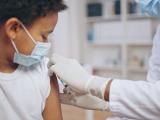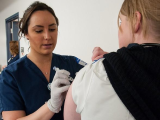Aug 18, 2009 (CIDRAP News) – Half a century ago, scientists reported evidence of some curious behavior by the immune system in humans and animals: If a host was exposed to an influenza virus and later encountered a variant strain of the same virus, the immune system responded to the second attack largely with the same weapons it used against the first one.
Like an army still fighting by the tactics of the last war, the host immune system mostly produced antibodies matched to the first virus instead of the second, resulting in a less effective defense. With a nod to theology, this phenomenon was labeled "original antigenic sin."
Today, in the face of the pandemic H1N1 flu virus, many countries are preparing to launch H1N1 vaccination campaigns this fall. Millions of people are in groups recommended to receive both seasonal flu immunizations and H1N1 vaccinations. Seasonal flu vaccine—which contains an H1N1 component, distantly related to the novel H1N1 virus—will be available sooner in most places.
This timing has caused some observers to wonder: If a person gets a seasonal flu shot and then an H1N1 dose a few weeks later, will original antigenic sin come into play and cause a poor response to the H1N1 vaccine?
Nobody knows the answer for sure, but leading flu and immunization experts say they aren't especially worried at this point. At the same time, they suggest the possibility bears watching.
"For the time being there is no cause for worry especially for vaccines because the influenza vaccines are really . . . very well known in terms of the seasonal use of these," said Dr. Marie-Paule Kieny, director of the World Health Organization's Initiative for Vaccine Research, in a recent news briefing.
But there is enough concern so that the H1N1 vaccine clinical trials recently announced by the National Institute of Allergy and Infectious Diseases (NIAID) will look into the question. Two of the trials will examine whether giving an H1N1 vaccine and seasonal flu vaccine sequentially or simultaneously affects the immune response to either vaccine, according to the NIAID's descriptions of the trials.
Study raises issue anew
A study published recently by the Journal of Immunology raised anew the question of original antigenic sin. Saying that some recent studies have raised doubts about the existence of the phenomenon, scientists at the Emory University Vaccine Center in Atlanta used three different approaches to look for evidence of original antigenic sin in mice. They found evidence of it under certain conditions.
The scientists used two human H1N1 viruses, labeled PR8 and FM1, that emerged in the 1930s and 1940s. They sequentially immunized mice with conventional vaccines using inactivated viruses, and they immunized other mice with DNA vaccines that encoded the hemagglutinin proteins from the two strains. In a third experiment, they sequentially exposed mice to the live viruses. The interval between the two inoculations in most cases was 1 month.
In the mice sequentially immunized with conventional vaccines, the team found minimal differences in antibody responses to the two strains. However, when the mice were then challenged with a high dose of the FM1 virus, the virus multiplied in their lungs far more than it did in the lungs of control mice that had received only the FM1 vaccine.
When mice were sequentially immunized with the DNA vaccines, the team found that the antibody response to the FM1 vaccine was oriented to the PR8 (original) vaccine, and antibodies to the FM1 strain were reduced, according to the report.
However, the original antigenic sin effect was much stronger in the mice that were infected with the two live viruses. "Sequential infection with live viruses generated severely reduced neutralization Ab [antibody] responses and compromised memory responses to the second virus," the report states. The authors suggest that this phenomenon helps explain the success and prevalence of flu viruses: when they mutate, the host immune system is fooled into responding to the predecessor strain instead of the mutated one.
Antigenic distance is key
On the other hand, original antigenic sin occurs only when the new strain is closely related to one the host has seen before, the scientists write. It is not known exactly how much antigenic similarity (likeness in the amino acid sequences of the hemagglutinin protein of the two strains) between the two strains is necessary to fool the immune system, but past studies have shown that antigenically distant or dissimilar strains fail to trigger original antigenic sin.
That finding seems to suggest that original antigenic sin would not be induced by a novel H1N1 immunization soon after getting a seasonal flu vaccine, as the new virus is not considered a close relative of the H1N1 strain in the seasonal vaccine.
In fact, that's the view of Robert G. Webster, PhD, a highly respected virologist and flu expert who did some of the original research on original antigenic sin decades ago. He is based at St. Jude Children's Research Hospital in Memphis.
"The antigenic distance between the seasonal H1N1 and swine flu is very large, so I don't think original antigenic sin is going to be a problem," Webster said in a recent interview.
He said that even if the phenomenon did arise, it might be possible to overcome it by using one of the newer vaccine adjuvants or by increasing the dose of vaccine. "With a larger dose, you can negate the original sin by sort of flooding the receptors with sufficient antigen to negate it," he said.
Jin H. Kim, PhD, a postdoctoral research associate at Emory and the lead author of the recent study, said the type of vaccine is important. He noted his finding that original antigenic sin was minimal when inactivated virus vaccines were used. Similarly, he said by e-mail, two recent studies found little evidence of original antigenic sin when humans received an inactivated vaccine against one seasonal flu strain and later were vaccinated against a drifted variant of that strain.
What about live-virus vaccines?
However, the finding that sequential exposure to live viruses invoked a greatly reduced response to the second virus raises the question whether the use of live attenuated vaccines for seasonal flu and the novel virus could lead to a similar response, Kim noted by e-mail. MedImmune, maker of the live attenuated seasonal vaccine FluMist, is also making a live version of novel H1N1 vaccine.
"It is [an] intriguing question whether the live attenuated vaccines would induce original antigenic sin," Kim said. "Our data show that sequential infection with related H1N1 viruses causes significant original antigenic sin and dampens the development of protective immunity. Therefore, it is possible that live attenuated swine origin H1N1 virus vaccine may behave similarly. However, it is important to note that we have not tested this in humans, thus this would be an immature conclusion at this point."
What if seasonal flu and novel H1N1 immunizations are given at the same time? John Treanor, MD, a vaccine researcher at the University of Rochester, said interference between the two vaccines is not likely to be a problem.
He noted that the seasonal vaccine itself normally contains three different strains of flu virus, and interference isn't a big concern. "In the absence of data, it's hard to be completely confident about the potential for interference when the seasonal vaccine is given at the same time as the H1N1 vaccine, but I think the hypothesis is that there will not be interference between components," he said.
Treanor commented that when two vaccines must be given in sequence rather than simultaneously, his view is that they should be separated by at least 2 weeks, mainly to prevent any confusion about attributing side effects. Cautioning that he is not an expert on original antigenic sin, he added, "I do not know if there is really any data that would suggest that such a schedule would or would not result in a decrease in the response to the novel H1N1 (or who knows, maybe an increase)," he said.
For Webster, original antigenic sin is only a minor concern in the current situation with regard to H1N1 vaccination.
"At the moment it's not a big issue, in my opinion," he said. "It's something we have at the back of our minds that we'll watch for. The new H1N1 is antigenically stable, vastly different from the seasonal H1N1, and we need to have vaccine for it wiki-wiki [very fast]."
See also:
Kim JH, Skountzou I, Compans R, et al. Original antigenic sin responses to influenza viruses. J Immunol 2009 (early online publication Jul 31) [Abstract]
Transcript of Aug 6 WHO news briefing
http://www.who.int/mediacentre/pandemic_h1n1_presstranscript_2009_08_06.pdf
Description of NIAID-sponsored trial examining sequential and simultaneous immunization of adults with seasonal and H1N1 vaccines from Sanofi Pasteur
http://clinicaltrials.gov/show/NCT00943878
Description of NIAID-sponsored trial examining sequential and simultaneous immunization of children with seasonal and H1N1 vaccines from Sanofi Pasteur
http://clinicaltrials.gov/show/NCT00943202



















